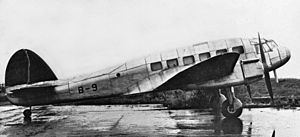Top speed 328 km/h Length 13 m | Wingspan 18 m Manufacturer Blackburn Aircraft | |
 | ||
The Blackburn H.S.T.10 (sometimes known as the Blackburn B-9) was a 1930s British twin-engined commercial monoplane, designed and built by Blackburn Aircraft at Brough, East Yorkshire.
Contents
Design and development
The H.S.T.10 was a low-wing cantilever monoplane powered by two Napier Rapier VI engines. It had a retractable conventional landing gear with an enclosed cabin for two pilots and twelve passengers. It was fitted with a single-spar all-metal wing, known as the Duncanson wing, that had previously been tested on a Blackburn Segrave. The prototype used test serial B-9. In 1937, the project was abandoned, and B-9 was given to Loughborough College as an instructional airframe.
Specifications
Data from Flight
General characteristics
Performance
References
Blackburn H.S.T.10 Wikipedia(Text) CC BY-SA
